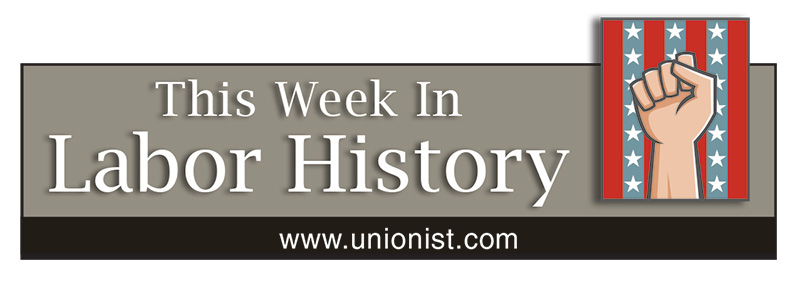This Week in Labor History March 11-17

MARCH 11
1811 – Luddites smash 63 “labor saving” textile machines near Nottingham, England.
1950 – Transport Workers Union members at American Airlines win 11-day national strike, gaining what the union says was the first severance pay clause in industry.
MARCH 12
1904 – The first tunnel under the Hudson River is completed after 30 years of drilling, connecting Jersey City and Manhattan. In just one of many tragedies during the project, 20 workers died on a single day in 1880 when the tunnel flooded.
1901 – Greedy industrialist turned benevolent philanthropist Andrew Carnegie pledges $5.2 million for the construction of 65 branch libraries in New York City — barely one percent of his net worth at the time. He established more than 2,500 libraries between 1900 and 1919 following years of treating workers in his steel plants brutally, demanding long hours in horrible conditions and fighting their efforts to unionize. Carnegie made $500 million when he sold out to J.P. Morgan, becoming the world’s richest man.
1912 – The Lawrence, Mass., “Bread and Roses” textile strike ends when the American Woolen Co. agrees to most of the strikers’ demands; other textile companies quickly followed suit.
2004 – Steelworkers approve a settlement with Oregon Steel Mills, Inc. and its CF&I Steel subsidiary, ending the longest labor dispute in the USWA’s history and resulting in more than $100 million in back pay for workers.
MARCH 13
1830 – The term “rat,” referring to a worker who betrays fellow workers, first appears in print in the New York Daily Sentinel. The newspaper was quoting a typesetter while reporting on replacement workers who had agreed to work for two-thirds of the going rate.
1946 – A four-month UAW strike at General Motors ends with a new contract. The strikers were trying to make up for the lack of wage hikes during World War II.
MARCH 14
1863 – Fabled railroad engineer John Luther “Casey” Jones born in southeast Missouri. A member of the Railroad Engineers, he was the sole fatality in a wreck near Vaughan, Miss., on April 29, 1900. His skill and heroics prevented many more deaths.
1914 – Henry Ford announced the new continuous motion method to assemble cars. The process decreased the time to make a car from 12 and a half hours to 93 minutes. Goodbye, craftsmanship. Hello, drudgery.
MARCH 15
1887 – Official formation of the Painters Int’l Union.
1917 – Supreme Court approves Eight-Hour Act under threat of a national railway strike.
1948 – Bituminous coal miners begin nationwide strike, demanding adoption of a pension plan.
MARCH 16
1960 – The United Federation of Teachers (UFT) is formed in New York to represent New York City public school teachers and, later, other education workers in the city.
MARCH 17
1890 – The leadership of the American Federation of Labor selects the Carpenters union to lead the eight-hour movement. Carpenters throughout the country strike in April; by May 1, some 46,000 carpenters in 137 cities and towns have achieved shorter hours.
1894 – A U.S.-China treaty prevents Chinese laborers from entering the U.S.
1968 – Staffers at San Francisco progressive rock station KMPX-FM strike, citing corporate control over what music is played and harassment over hair and clothing styles, among other things. The Rolling Stones, Joan Baez, the Jefferson Airplane, the Grateful Dead and other musicians request that the station not play their music as long as the station is run by strikebreakers.
2000 – Boeing Co. and the Society of Professional Engineering Employees in Aerospace (SPEEA) come to terms on a new contract, settling the largest white-collar walkout in U.S. history. SPEEA represented some 22,000 workers, of whom 19,000 honored picket lines for 40 days.
(Compiled by David Prosten, founder Union Communication Services)


Leave a Reply